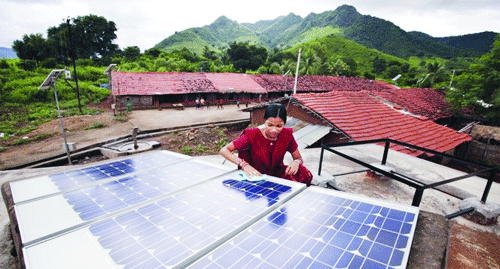There are elements in this year's Union Budget which meet the objectives of sustainability, but what would also be extremely important is for India to pursue a path of growth which is climate resilient
This year’s Budget presented by Union Minister for Finance Arun Jaitley has several distinctive features, which deserve attention and support. As the Finance Minister mentioned in his speech, in the midst of the global economic crisis which is afflicting every country in the world, including China, India’s performance stands out as a shining example of good economic management. The Government deserves to be congratulated for maintaining the fiscal deficit target at 3.5 per cent of GDP and for having contained inflationary pressures quite successfully thus far. However, with the head winds which are blowing from the dismal performance of other countries and the impending burden of higher Government salaries consequent on the recommendations of the Seventh Central Pay Commission, the Government has limited options for promoting growth through fiscal measures.
This year’s Budget has clearly targeted the challenge being faced by the farming sector and the rural parts of this country. This change in emphasis is indeed a small step towards correcting some of the chronic problems that India has done little to address over the years. In this column on December 4, 2015, the persistent neglect of rural areas had been highlighted and arguments put forward for India to focus on agriculture and rural development far more seriously than it has done in the past. It is also to be kept in mind that with a growing population worldwide and limitations on land available for agriculture, the problem of global food security would become far more serious than we have seen in the past. Promoting agriculture and rural development would not only improve our external trade significantly but also increasing incomes for our farmers, which as a consequence would lead to greater development of rural India and the economy as a whole. The Government’s programme on Smart Cities would have limited success if migration by unemployed rural youth floods our towns and cities with an expansion of degrading slum existence.
However, it is essential to create institutional capacity and capabilities to ensure that rural areas develop in a sustainable manner. In September, 2015, the UN General Assembly adopted 17 Sustainable Development Goals, which include the achievement of no poverty, zero hunger, good health and well-being, quality education, clean water and sanitation, and affordable and clean energy, apart from several other essential goals that would lead human society to a higher level of well-being. In the case of rural India, while the Budget envisages that all non-electrified villages will receive electricity in the next 1,000 days, this would not translate into electricity reaching the homes of rural dwellers. There is a serious dichotomy across the country in which the number of villages ‘electrified’ exceeds by far the number with electrification of homes. The objectives of sustainable development would require that a large number of these non-electrified villages should be lit up with decentralised renewable energy supply. TERI’s lighting a Billion lives campaign has shown that rural entrepreneurs can be mobilised to establish micro-grids for supplying photovoltaic power to homes for providing villages with clean lighting without necessarily extending the grid from centralised power generation. In the aggregate, the number of jobs generated per kilowatt of decentralised energy supply is much larger than with centralised power generation. One major benefit of decentralised renewable energy supply lies in the potential for villages to ensure that,beginning with lighting, the next step would be towards energy supply for establishing micro enterprises. A totally new opportunity would thus be created for removing rural poverty and bringing about sustainable development of villages by development of economic activities locally rather than in or around our towns and cities.
Another major emphasis in this year’s Budget is in improved management of water, including the establishment of farm ponds and dug wells in rainfed areas. The target of 10 lakh compost pits is also desirable as is the emphasis on promoting and maintaining soil health and encouraging organic farming. The allocation of lPG connections, essentially as a substitute for biomass-based cooking, is also a move in the right direction. The financing of measures for cleaning the environment would presumably be larger as proposed in the budget on account of the increase in the Clean Environment Cess from Rs200 to Rs400 per tonne. However, the bureaucratic hurdles in the utilisation of this fund need to be removed, and the ministries concerned as well as civil society should be empowered to come up with specific plans and receive funding in a coordinated and pre-planned manner from this source, and not through projects that are developed as an afterthought.
The efforts to expand new infrastructure for irrigation is a desirable objective, but it would be essential for the Centre to work with the States to ensure rational water tariffs, so that water-use efficiency is improved in every sector of the economy, particularly agriculture. In fact, the Budget provided the Finance Minister with a unique opportunity for introducing fiscal incentives and disincentives to promote efficiency in the use of all forms of resources. While the housing sector has received attention and may experience a boost, it would have helped greatly if the Government had also specified a set of incentives and disincentives for resource use based on the rating system, GRIHA, which has been highlighted in India’s Intended Nationally Determined Contribution before the 21st Conference of the Parties held in Paris.
The Government needs to be congratulated for a differential cess on automobiles based on their size and horsepower, but perhaps the differential cess could have been substantially higher. Taxing luxury automobiles at a higher level would also be an effective way of taxing the rich, who otherwise find ingenious ways of evading taxes. More importantly, this would lead to a higher level of energy efficiency in the transport sector, an area urgently needing major transformation.
There are elements in this year’s Budget which meet the objectives of sustainability, but what would also be extremely important is for India to pursue a path of growth which is climate resilient. There is growing scientific evidence that even the recurrence of droughts in several parts of the country, and frequent extreme precipitation events and heat waves, are the consequences of climate change. India, therefore, has to come up with adaptation strategies, which are comprehensive. The Finance Minister could have dealt with this aspect in his speech and built in climate resilience as an objective. This, of course, can still be done, and it is hoped that the Union Government will focus on this area in its actions.
(The writer is executive vice chairman, TERI)
























